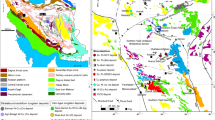Abstract
The evolution of the magmatic-hydrothermal system that formed the Eocene Yulong Cu-Mo porphyry deposit of the eastern Tibetan Plateau, China, is reconstructed based on the study of the sequence of stockwork vein sets showing systematic crosscutting relationships in hand specimen. Early A veins associated with potassic alteration of the porphyritic host are composed of vitreous quartz that is extensively recrystallized and has a dark blue cathodoluminescence. Fluid inclusions contained in the quartz have been affected by post-entrapment modification. Some of the A veins were reopened and contain ribbons of microscopic molybdenite flakes. Formation of the molybdenite was associated with recrystallization of the earlier formed quartz and concomitant with the development of a dark purple to brownish cathodoluminescence signature. Reopening of the early veins also resulted in the formation of AB veins containing euhedral quartz crystals that contain encapsulated molybdenite flakes and are intergrown with coarse laths of molybdenite. These euhedral quartz crystals showing a dark purple to brownish cathodoluminescence host vapor-rich, intermediate-density fluid inclusions as well as hypersaline liquid and vapor-rich fluid inclusions, indicating that fluid immiscibility at hydrostatic pressure conditions occurred during crystal growth. Later, C veins that crosscut and commonly reopen the earlier A and AB veins lack quartz as a gangue mineral and consist entirely of chalcopyrite and pyrite with minor molybdenite. Sulfide formation was accompanied by chlorite or sericite alteration of the wall rocks. Late D veins containing quartz and pyrite with associated sericitic alteration of the porphyritic wall rocks crosscut all earlier vein types. Only minor amounts of molybdenite and chalcopyrite are present. Euhedral quartz crystals in the D veins contain liquid-rich fluid inclusions that have not been affected by post-entrapment modification. The results of this study indicate that Mo and Cu mineralization at Yulong was introduced by single-phase, intermediate-density magmatic-hydrothermal fluids as the porphyry system was transitioning from ductile to brittle conditions. The bulk of the Mo endowment predated Cu mineralization and formed during the change from lithostatic to hydrostatic conditions and associated immiscibility of the magmatic-hydrothermal fluids. Chalcopyrite precipitation followed as the single-phase, intermediate-density magmatic-hydrothermal fluids was escaping into the hydrostatic-pressured regime. Cooling of the magmatic-hydrothermal fluids appears to have been the principal control on metal precipitation.










Similar content being viewed by others
References
Akinfiev NN, Diamond LW (2009) A simple predictive model of quartz solubility in water-salt-CO2 systems at temperatures up to 1000°C and pressures up to 1000 MPa. Geochim Cosmochim Acta 73:1597–1608
Arancibia ON, Clark AH (1996) Early magnetite-amphibole-plagioclase alteration-mineralization in the Island Copper porphyry copper-gold-molybdenum deposit, British Columbia. Econ Geol 91:402–438
Barra F, Ruiz J, Mathur R, Titley S (2003) A Re-Os study of sulfide minerals from the Bagdad porphyry Cu-Mo deposit, northern Arizona, USA. Mineral Deposita 38:585–596
Bierlein FP, Potma W, Cernuschi F, Brauhart C, Robinson J, Bargmann CJ, Bullen W, Henriquez JF, Davies I, Kennedy A (2020) New insights into the evolution and age of the Neoproterozoic Jebel Ohier porphyry copper deposit, Red Sea Hills, northeastern Sudan. Econ Geol 115:1–31
Chang J, Li JW, Selby D, Liu JC, Deng XD (2017) Geological and chronological constraints on the long-lived Eocene Yulong porphyry Cu-Mo deposit, eastern Tibet: implications for the lifespan of giant porphyry Cu deposits. Econ Geol 112:1719–1746
Chang J, Li JW, Audétat A (2018) Formation and evolution of multistage magmatic-hydrothermal fluids at the Yulong porphyry Cu-Mo deposit, eastern Tibet: insights from LA-ICP-MS analysis of fluid inclusions. Geochim Cosmochim Acta 232:181–205
Clark AH (1993) Are outsize porphyry copper deposits either anatomically or environmentally distinctive? SEG Spec Pub 2:213–283
Clode C, Proffett J, Mitchell P, Munajat I (1999) Relationships of intrusion, wall-rock alteration and mineralisation in the Batu Hijau copper-gold porphyry deposit. In: Weber G (ed) PACRIM’99 Congress, Proceedings of the International Congress on Earth Science, Exploration and Mining around the Pacific Rim. Australasian Institute of Mining and Metallurgy, Carlton, pp 485–498
Deng XD, Li JW, Shuster DL (2017) Late Mio-Pliocene chemical weathering of the Yulong porphyry Cu deposit in the eastern Tibetan Plateau constrained by goethite (U-Th)/He dating: implications for Asian summer monsoon. Earth Planet Sci Lett 472:289–298
Dilles JH, Einaudi MT (1992) Wall-rock alteration and hydrothermal flow paths about the Ann-Mason porphyry copper deposit, Nevada—a 6-km vertical reconstruction. Econ Geol 87:1963–2001
Driesner T, Heinrich CA (2007) The system H2O–NaCl. Part I: correlation formulae for phase relations in temperature–pressure–composition space from 0 to 1000°C, 0 to 5000 bar, and 0 to 1 XNaCl. Geochim Cosmochim Acta 71:4880–4901
Fall A, Bodnar RJ (2018) How precisely can the temperature of a fluid event be constrained using fluid inclusions? Econ Geol 113:1817–1843
Fournier RO (1967) The porphyry copper deposit exposed in the Liberty open-pit mine near Ely, Nevada. Part I. Syngenetic formation. Econ Geol 62:57–81
Fournier RO (1991) The transition from hydrostatic to greater than hydrostatic fluid pressure in presently active continental hydrothermal systems in crystalline rock. Geophys Res Lett 18:955–958
Fournier RO (1999) Hydrothermal processes related to movement of fluid from plastic into brittle rock in the magmatic-epithermal environment. Econ Geol 94:1193–1211
Franchini M, McFarlane C, Maydagán L, Reich M, Lentz DR, Meinert L, Bouhier V (2015) Trace metals in pyrite and marcasite from the Agua Rica porphyry-high sulfidation epithermal deposit, Catamarca, Argentina: textural features and metal zoning at the porphyry to epithermal transition. Ore Geol Rev 66:366–387
Goldstein RH, Reynolds TJ (1994) Systematics of fluid inclusions in diagenetic minerals. SEPM Short Course 31
Gruen G, Heinrich CA, Schroeder K (2010) The Bingham Canyon porphyry Cu-Mo-Au deposit. II. Vein geometry and ore shell formation by pressure-driven rock extension. Econ Geol 105:69–90
Gu XX, Tang JX, Wang CS, Chen JP, He BB (2003) Himalayan magmatism and porphyry copper-molybdenum mineralization in the Yulong ore belt, East Tibet. Mineral Petrol 78:1–20
Guo LG, Liu YP, Xu W, Zhang XC, Qin KZ, Li TS, Shi YR (2006) Constraints to the mineralization age of the Yulong porphyry copper deposit from SHRIMP U-Pb zircon data in Tibet. Acta Petrol Sin 22:1009–1016
Gustafson LB, Hunt JP (1975) The porphyry copper deposit at El Salvador, Chile. Econ Geol 70:857–912
Gustafson LB, Quiroga J (1995) Patterns of mineralization and alteration below the porphyry copper orebody at El Salvador, Chile. Econ Geol 90:2–16
Hedenquist JW, Arribas A, Reynolds TJ (1998) Evolution of an intrusion-centered hydrothermal system: far Southeast-Lepanto porphyry and epithermal Cu-Au deposits, Philippines. Econ Geol 93:373–404
Hezarkhani A, Williams-Jones AE (1998) Controls of alteration and mineralization in the Sungun porphyry copper deposit, Iran: evidence from fluid inclusions and stable isotopes. Econ Geol 93:651–670
Hou ZQ, Ma HW, Zaw K, Zhang YQ, Wang MJ, Wang Z, Pan GT, Tang RL (2003) The Himalayan Yulong porphyry copper belt: product of large-scale strike-slip faulting in eastern Tibet. Econ Geol 98:125–145
Hou ZQ, Xie YL, Xu WY, Li YQ, Zhu XK, Zaw K, Beaudoin G, Rui ZY, Huang W, Luobu C (2007) Yulong deposit, eastern Tibet: a high-sulfidation Cu–Au porphyry copper deposit in the eastern Indo-Asian collision zone. Int Geol Rev 49:235–258
Hurtig NC, Williams-Jones AE (2014) An experimental study of the solubility of MoO3 in aqueous vapour and low to intermediate density supercritical fluids. Geochim Cosmochim Acta 136:169–193
Hurtig NC, Williams-Jones AE (2015) Porphyry-epithermal Au-Ag-Mo ore formation by vapor-like fluids: new insights from geochemical modeling. Geology 43:587–590
Imai A, Ohno S (2005) Primary ore mineral assemblage and fluid inclusion study of the Batu Hijau porphyry Cu-Au deposit, Sumbawa, Indonesia. Resour Geol 55:239–248
Johnson JW, Norton D (1991) Critical phenomena in hydrothermal systems: state, thermodynamic, electrostatic, and transport properties of H2O in the critical region. Am J Sci 291:541–648
Kirwin DJ, Forster CN, Kavalieris I, Crane D, Orssich C, Panther C, Garamjav D, Munkhbat TO, Niislelkhuu G (2005) The Oyu Tolgoi copper-gold porphyry deposits, South Gobi, Mongolia. IAGOD Guideb Ser 11:155–168
Klemm LM, Pettke T, Heinrich CA, Campos E (2007) Hydrothermal evolution of the El Teniente deposit, Chile: porphyry Cu-Mo ore deposition from low-salinity magmatic fluids. Econ Geol 102:1021–1045
Klemm LM, Pettke T, Heinrich CA (2008) Fluid and source magma evolution of the Questa porphyry Mo deposit, New Mexico, USA. Mineral Deposita 43:533–552
Klyukin YI, Driesner T, Steele-MacInnis M, Lowell RP, Bodnar RJ (2016) Effect of salinity on mass and energy transport by hydrothermal fluids based on the physical and thermodynamic properties of H2O-NaCl. Geofluids 16:585–603
Klyukin YI, Steele-MacInnis M, Lecumberri-Sanchez P, Bodnar RJ (2019) Fluid inclusion phase ratios, compositions and densities from ambient temperature to homogenization, based on PVTX properties of H2O-NaCl: Earth-Sci Rev 198:102924
Kouzmanov K, Pokrovski GS (2012) Hydrothermal controls on metal distribution in porphyry Cu (-Mo-Au) systems. SEG Spec Pub 16:573–618
Landtwing MR, Pettke T (2005) Relationships between SEM-cathodoluminescence response and trace-element composition of hydrothermal vein quartz. Am Mineral 90:122–131
Landtwing MR, Pettke T, Halter WE, Heinrich CA, Redmond PB, Einaudi MT, Kunze K (2005) Copper deposition during quartz dissolution by cooling magmatic–hydrothermal fluids: the Bingham porphyry. Earth Planet Sci Lett 235:229–243
Landtwing MR, Furrer C, Redmond PB, Pettke T, Guillong M, Heinrich CA (2010) The Bingham Canyon porphyry Cu-Mo-Au deposit. III. Zoned copper-gold ore deposition by magmatic vapor expansion. Econ Geol 105:91–118
Li J, Qin K, Li G, Cao M, Xiao B, Chen L, Zhao J, Evans NJ, McInnes BIA (2012) Petrogenesis and thermal history of the Yulong porphyry copper deposit, Eastern Tibet: insights from U-Pb and U-Th/He dating, and zircon Hf isotope and trace element analysis. Mineral Petrol 105:201–221
Liang HY, Campbell IH, Allen C, Sun WD, Liu CQ, Yu HX, Xie YW, Zhang YQ (2006) Zircon Ce4+/Ce3+ ratios and ages for Yulong ore-bearing porphyries in eastern Tibet. Mineral Deposita 41:152–159
Liang HY, Mo JS, Sun WD, Yu HX, Zhang YQ, Allen CM (2008) Study on the duration of the ore-forming system of the Yulong giant porphyry copper deposit in eastern Tibet, China. Acta Petrol Sin 24:2352–2358
Manske SL, Paul AH (2002) Geology of a major new porphyry copper center in the Superior (Pioneer) district, Arizona. Econ Geol 97:197–220
Masterman GJ, Cooke DR, Berry RF, Walshe JL, Lee AW, Clark AH (2005) Fluid chemistry, structural setting, and emplacement history of the Rosario Cu-Mo porphyry and Cu-Ag-Au epithermal veins, Collahuasi district, northern Chile. Econ Geol 100:835–862
Monecke T, Monecke J, Reynolds TJ, Tsuruoka S, Bennett MM, Skewes WB, Palin R (2018) Quartz solubility in the H2O-NaCl system: a framework for understanding vein formation in porphyry copper deposits. Econ Geol 113:1007–1046
Monecke T, Monecke J, Reynolds TJ (2019) The influence of CO2 on the solubility of quartz in single-phase hydrothermal fluids: implications for the formation of stockwork veins in porphyry copper deposits. Econ Geol 114:1195–1206
Müller A, Herrington R, Armstrong R, Seltmann R, Kirwin DJ, Stenina NG, Kronz A (2010) Trace elements and cathodoluminescence of quartz in stockwork veins of Mongolian porphyry-style deposits. Mineral Deposita 45:707–727
Muntean JL, Einaudi MT (2000) Porphyry gold deposits of the Refugio district, Maricunga belt, northern Chile. Econ Geol 95:1445–1472
Murakami H, Seo JH, Heinrich CA (2010) The relation between Cu/Au ratio and formation depth of porphyry-style Cu-Au±Mo deposits. Mineral Deposita 45:11–21
Neuser RD (1995) A new high-intensity cathodoluminescence microscope and its application to weakly luminescing minerals. Bochum Geol Geotechn Arb 44:116–118
Nielsen RL (1968) Hypogene texture and mineral zoning in a copper-bearing granodiorite porphyry stock, Santa Rita, New Mexico. Econ Geol 63:37–50
Norton DL, Dutrow BL (2001) Complex behavior of magma-hydrothermal processes: role of supercritical fluid. Geochim Cosmochim Acta 65:4009–4017
Norton D, Knight J (1977) Transport phenomena in hydrothermal systems: cooling plutons. Am J Sci 277:937–981
Penniston-Dorland SC (2001) Illumination of vein quartz textures in a porphyry copper ore deposit using scanned cathodoluminescence: Grasberg igneous complex, Irian Jaya, Indonesia. Am Mineral 86:652–666
Perelló JA, Fleming JA, O’Kane KP, Burt PD, Clarke GA, Himes MD, Reeves AT, Schroeter TG (1995) Porphyry copper-gold-molybdenum deposits in the Island Copper cluster, northern Vancouver Island, British Columbia. CIM Spec 46:214–238
Pudack C, Halter WE, Heinrich CA, Pettke T (2009) Evolution of magmatic vapor to gold-rich epithermal liquid: the porphyry to epithermal transition at Nevados de Famatina, northwest Argentina. Econ Geol 104:449–477
Redmond PB, Einaudi MT (2010) The Bingham Canyon porphyry Cu-Mo-Au deposit. I. Sequence of intrusions, vein formation, and sulfide deposition. Econ Geol 105:43–68
Redmond PB, Einaudi MT, Inan EE, Landtwing MR, Heinrich CA (2004) Copper deposition by fluid cooling in intrusion-centered systems: new insights from the Bingham porphyry ore deposit, Utah. Geology 32:217–220
Reed M, Rusk B, Palandri J (2013) The Butte magmatic-hydrothermal system: one fluid yields all alteration and veins. Econ Geol 108:1379–1396
Rempel KU, Williams-Jones AE, Migdisov AA (2008) The solubility of molybdenum dioxide and trioxide in HCl-bearing water vapour at 350°C and pressures up to 160 bars. Geochim Cosmochim Acta 72:3074–3083
Reynolds TJ, Beane RE (1985) Evolution of hydrothermal fluid characteristics at the Santa Rita, New Mexico, porphyry copper deposit. Econ Geol 80:1328–1347
Rusk BG, Reed MH, Dilles JH, Klemm LM, Heinrich CA (2004) Compositions of magmatic hydrothermal fluids determined by LA-ICP-MS of fluid inclusions from the porphyry copper-molybdenum deposit at Butte, MT. Chem Geol 210:173–199
Rusk BG, Reed MH, Dilles JH (2008) Fluid inclusion evidence for magmatic-hydrothermal fluid evolution in the porphyry copper-molybdenum deposit at Butte, Montana. Econ Geol 103:307–334
Seedorff E, Dilles JH, Proffett JM, Einaudi MT, Zurcher L, Stavast WJA, Johnson DA, Barton MD (2005) Porphyry deposits: characteristics and origin of hypogene features. In: Hedenquist JW, Thompson JFH, Goldfarb RJ, Richards JP (eds) Economic geology 100th anniversary volume. Society of Economic Geologists, Littleton, pp 251–298
Seo JH, Guillong M, Heinrich CA (2012) Separation of molybdenum and copper in porphyry deposits: the roles of sulfur, redox, and pH in ore mineral deposition at Bingham Canyon. Econ Geol 107:333–356
Sillitoe RH (2010) Porphyry copper systems. Econ Geol 105:3–41
Skewes WB (2016) Evolution of magmatic-hydrothermal systems below boiling conditions: evidence from the Çöpler Au-Cu deposit, east central Turkey. MS thesis, Colorado School of Mines, Golden
Spencer ET, Wilkinson JJ, Creaser RA, Seguel J (2015) The distribution and timing of molybdenite mineralization at the El Teniente Cu-Mo porphyry deposit, Chile. Econ Geol 110:387–421
Stefanova E, Driesner T, Zajacz Z, Heinrich CA, Petrov P, Vasilev Z (2014) Melt and fluid inclusions in hydrothermal veins: the magmatic to hydrothermal evolution of the Elatsite porphyry Cu-Au deposit, Bulgaria. Econ Geol 109:1359–1381
Sterner SM, Bodnar RJ (1989) Synthetic fluid inclusions—VII. Re-equilibration of fluid inclusions in quartz during laboratory-simulated metamorphic burial and uplift. J Metamorph Geol 7:243–260
Sun MY, Qu HC, Li QY, Zhou LM, Yang ZM, Liu ST, Liu YG (2015) Recognition of the ore-forming porphyry in the Yulong Cu deposit and its geological significance. Acta Petrol Mineral 34:493–504
Tang RL, Luo HS (1995) The geology of Yulong porphyry copper (molybdenum) ore belt, Xizang (Tibet). Geological Publishing House, Beijing
Tsuruoka S (2017) The evolution of hydrothermal fluids from the deep porphyry environment to the shallow epithermal environment. PhD thesis, Colorado School of Mines, Golden, Colorado, USA
Vry VH, Wilkinson JJ, Seguel J, Millán J (2010) Multistage intrusion, brecciation, and veining at El Teniente, Chile: evolution of a nested porphyry system. Econ Geol 105:119–153
Wang ZL, Yang ZM, Yang ZS, Tian SH, Liu YC, Ma YQ, Wang GR, Qu WJ (2008) Narigongma porphyry molybdenite copper deposit, northern extension of Yulong copper belt: evidence from the age of Re-Os isotope. Acta Petrol Sin 24:503–510
Weis P, Driesner T, Heinrich CA (2012) Porphyry-copper ore shells form at stable pressure-temperature fronts within dynamic fluid plumes. Science 338:1613–1616
Yang ZM, Cooke DR (2019) Porphyry copper deposits in China. SEG Spec Pub 22:133–187
Yang Z, Hou Z, White NC, Chang Z, Li Z, Song Y (2009) Geology of the post-collisional porphyry copper-molybdenum deposit at Qulong, Tibet. Ore Geol Rev 36:133–159
Acknowledgments
We thank Kang Cao, Qiuyun Li, Lei Lin, Shentai Liu, Lingchao Mo, Huanchun Qu, Jiayu Zhang, and Limin Zhou for help provided during the field work. Tibet Yulong Copper Ltd. is acknowledged for permission to conduct the research. Jia Chang is thanked for discussions on the geology of Yulong and the results of previous fluid inclusion research. The manuscript benefited from constructive reviews by Bertrand Rottier and Matthieu Harlaux. Robert Moritz is thanked for editorial handling.
Funding
This work was funded by the National Key Research and Development Project of China (grant 2016YFC0600305), the National Natural Science Foundation of China (grants 41825005, 41320104004, 41273051, 41473041), and the Ministry of Land and Resources of China (grant 201011011).
Author information
Authors and Affiliations
Corresponding author
Additional information
Editorial handling: R. Moritz
Publisher’s note
Springer Nature remains neutral with regard to jurisdictional claims in published maps and institutional affiliations.
Rights and permissions
About this article
Cite this article
Sun, M., Monecke, T., Reynolds, T.J. et al. Understanding the evolution of magmatic-hydrothermal systems based on microtextural relationships, fluid inclusion petrography, and quartz solubility constraints: insights into the formation of the Yulong Cu-Mo porphyry deposit, eastern Tibetan Plateau, China. Miner Deposita 56, 823–842 (2021). https://doi.org/10.1007/s00126-020-01003-6
Received:
Accepted:
Published:
Issue Date:
DOI: https://doi.org/10.1007/s00126-020-01003-6




